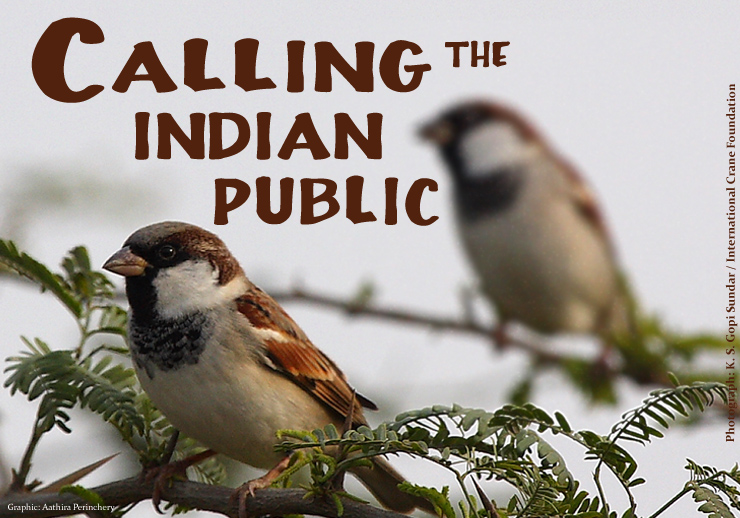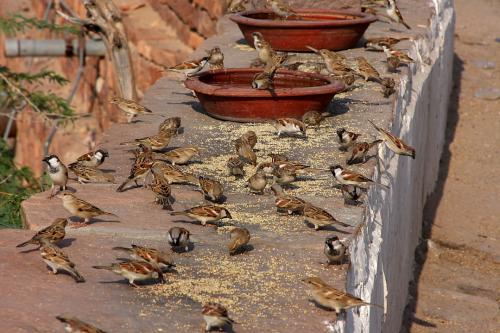Calling the Indian Public
House sparrow (Passer domesticus) populations in Europe have declined so drastically that in 2010, Britain's Royal Society for the Protection of Birds listed the house sparrow in the Red List of endangered avian species. Back home in India, the sparrow's plight is not enviable either. These once-omnipresent birds are no longer as common as they used to be: a fact Indians from all walks of life have woken up to. Scientists, students, home makers, grocery shop owners - everyone talks about it now. Speculations about the cause of this decline are many: radiation from mobile towers, changes in house architecture, rampant pesticide use, pollution. But to find the true reasons behind the mysterious decline, you need basic information about sparrows first.
It's no surprise then that a group of organisations have joined forces to deal with some key questions. Where are sparrows still found in India? Where were they found before? In which places have they declined the most? These are some of the questions Citizen Sparrow, a public participatory program launched on 1st April 2012 will try to answer. "There is an urgent need to understand the status of our commonest bird, the ubiquitous House Sparrow. Only a citizen science program with mass participation can help in collecting information about it on a pan-India scale," says Raju Kasambe of the Indian Bird Conservation Network, Mumbai and a member of the Citizen Sparrow project.
Citizen Sparrow: The Project
It all began when Karthik K., a master's student at the TERI University decided he wanted to work on the status of sparrows for his master's thesis project. As part of this work, he visualized an online database where people in India could contribute sparrow sightings. As the idea spread, more people and organizations showed interest in it. Now, Citizen Sparrow is a nation-wide project targeted at recording the presence and absence of house sparrows, organized by the Bombay Natural History Society (BNHS). It is partnered by the Nature Conservation Foundation (NCF) and the Citizen Science Program at the National Centre for Biological Sciences (NCBS). Karthik is the Project Coordinator for Citizen Sparrow and is currently pursuing related field work in Bangalore.
Citizen Sparrow is an online database (www.citizensparrow.in) that accepts reports and sightings of house sparrows across India. The program will accept entries till the 31st of May 2012. You can create an account for yourself on the website, log in and answer a set of questions that researchers have put together. The questions are aimed at gleaning as much information about each of your sparrow sightings as possible. Detailed questions include the specific locality you saw the sparrows in, the numbers of birds you saw and the active sparrow nests you observed in the vicinity during that time.
But it's not just current information about sparrows you can submit. One of the aims of Citizen Sparrow is to compare sparrow populations at one locality between different time periods. So participants can submit multiple sightings of sparrows from different time periods (for example, 2010-2012, 2005-2009 and so on) for the same locality. You can also contribute one-off records of sparrow sightings if you saw them while traveling through a new locality. All information is valuable.
The Importance of Absence
Even information about sparrow absence is precious. While it's natural for people to refrain from offering any information about not seeing sparrows in an area, this information will help scientists examine the potential reasons as to why sparrows could be absent in these localities in the first place.
With all this information, scientists hope they will be able to make preliminary comparisons of sparrow population change in different places. The patterns found in this broad-brush study would then need to be followed up with more detailed investigations.
Reaching Out
Put together, that should be a lot of pretty interesting information. Information that will have to be gathered from across the entire country - and in large numbers. So unlike most science projects where data is collected by scientists or trained students, Citizen Sparrow relies on people across India to contribute information. "Almost everyone knows about House Sparrows, so there is a vast store of information available with citizens all across the country. We are trying to document this store of information. In addition, we see this as a way to reach out to people from all walks of life -- asking them to share their stories and their understanding about these birds," says Suhel Quader, a scientist with the Nature Conservation Foundation, Mysore, and Head of Citizen Science at NCBS.
So the Citizen Sparrow team has done all they can to inform the Indian public about this venture. Television shows, radio programs, newspaper articles - the Indian press has played a huge role in popularizing Citizen Sparrow. You can access some of the newspaper articles here:
http://www.thehindu.com/news/cities/Delhi/article3287189.ece
http://www.thehindu.com/todays-paper/tp-national/tp-andhrapradesh/article3268211.ece
http://www.thehindu.com/sci-tech/energy-and-environment/article3307631.ece
http://articles.timesofindia.indiatimes.com/2012-04-04/bangalore/31287156_1_sparrows-survey-birds
The program also has its very own Wikipedia and Facebook pages (http://en.wikipedia.org/wiki/Citizen_Sparrow and https://www.facebook.com/events/272483089501473/). A number of organizations including the Madras Crocodile Bank Trust, Sanctuary Asia, Foundation for Ecological Research, Advocacy and Learning and the Salim Ali Centre for Ornithology and Natural History are collaborating to help out with the project in many ways. You can view the full list of organisations working with Citizen Sparrow here (http://www.citizensparrow.in/index.php?r=site/page&view=partners).
When this story was written, there were 8094 entries. 4887 participants have logged in their sparrow sightings across 6489 locations: from places as diverse as Rajouri in Jammu and Kashmir (near Pakistan) to Baghmara, on the Bangladesh-India border in Meghalaya. Is 8094 a good number? "We initially set our target very high, at 20,000 responses," says Quader. "But we're delighted at the response, and are working hard to increase participation in these last two weeks of the project."
As of 12th May, a majority of the sparrow sightings are in the time period between 2010-2012. State-wise, Maharashtra leads participation by a huge margin, followed by Tamil Nadu and Karnataka. Most contributions are largely from cities and their outskirts. The glitch with a web-based database seems obvious here: only the fraction of Indians who have access to the internet and know how to operate a computer can contribute their sightings online. To decrease this bias in reports, scientists with Citizen Sparrow are now designing a questionnaire that can be printed out by volunteers, taken around and answers filled in. The volunteers will then upload the entries to the online database. Citizen Sparrow will bank on participants registered with the database to volunteer for this activity. The questionnaire will also be translated into eight Indian languages - Hindi, Marathi, Gujarati, Bengali, Malayalam, Tamil, Kannada and Telugu: and organizers hope this will increase contributions multifold. "With the questionnaires, we're hoping we will also have more information on previous time periods," says Quader.
Other collaborating organizations are also coming up with useful alternatives. The OSAI Environmental Organization based at Coimbatore (Tamil Nadu) for instance, has set up a telephone help line at Coimbatore, where people can call and submit their sparrow sightings to a volunteer on the other end of the telephone. The volunteers then upload the records online.
Where does all this information go?
All information collected through the project will be placed in the public domain for anyone to access and use. At the end of May when the survey closes, the data will be analyzed by scientists working with Citizen Sparrow, the results of which will be made accessible as a report. Organizers hope that this will throw up new questions or identify potential issues that sparrows in India face, which can be pursued by any interested individual or organization.
So visit www.citizensparrow.in right away and do your bit to contribute to the project. And spread the word - each entry is valuable to unraveling possible reasons behind the mysterious sparrow decline in India.



Comments
Request to see this little
Post new comment